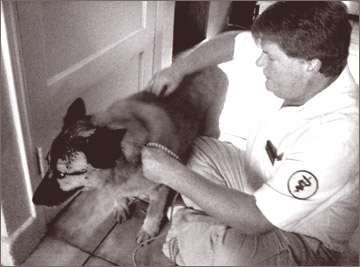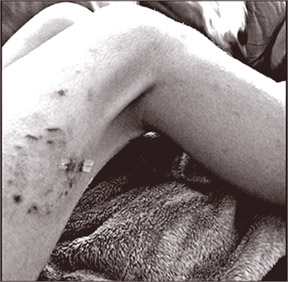Towards a rabies-free Sri Lanka
by Dr. Allagamuthu NANDAKUMAR
 The bond between man and dog has its beginnings running back 12-14
millennia to somewhere in Eurasia where a reciprocal relationship
between the two emerged. The bond between man and dog has its beginnings running back 12-14
millennia to somewhere in Eurasia where a reciprocal relationship
between the two emerged.
Since the news item ‘Sri Lanka targets three million dogs for mass
cull’ was published, much activity has been seen among animal lovers and
animal welfare groups. Many newspaper articles have also been published
in this regard.
Killing of dogs under the Rabies Ordinance introduced by the British
rulers 100 years ago was stopped by Local Government authorities, since
President Mahinda Rajapaksa's ‘No kill policy’ was introduced in 2006.
As per the statistics released by the Ministry of Health, over 2,000
people receive the human rabies vaccine daily. In 2011 over 397,825
people were treated in government hospitals for hydrophobia (human
rabies) and 49 died of the disease.
Over 80 percent of the funds on rabies control programs in the past
were spent on the importation of human vaccine. It is now believed that
the best way to reduce the stray dog menace and the spread of rabies is
through a sterilisation and vaccination program, popularly known as
ABC-AR (Animal Birth Control-Anti Rabies).
Sri Lanka has all the regulations to suit the nation, but these are
not followed properly. When someone owns a dog, he or she is faced with
a legal responsibility as well as a moral one. Generally, keeping dogs
does not present problems to the public, unless the owners allow it to
become a nuisance by letting their dogs stray. If all dog owners and
officials behaved in a responsible manner, then the problem of stray
dogs (the main cause) would be reduced to a minimum.
Laws around the world
|

Stray dogs roaming the streets |
Historically, a charge for keeping dogs as pets was first levied in
Britain as far back as 1796, to raise revenue. In general, different
countries have different laws. In the UK every dog at the age of four
months, has to be registered with the local authority. In the USA, laws
regulating dog ownership are so many and so complex that each state has
the power to regulate its own law pertaining to dog ownership.
In China rabies is the top infectious disease, ahead of TB and
HIV/AIDS. China has the second highest case of rabies in the world, next
to India. The registration of dog ownership licence in China was reduced
from 5,000 Yuan (US$ 600) to 1,000 Yuan (US$ 120) in 2003. Large breeds
of dogs are prohibited there and one family can own only one dog.
If caught with unregistered dogs, owners will be fined from 2,000
Yuan onwards (US$ 240).
In Singapore too, large breeds are prohibited. Every dog over three
months has to be registered at a cost of 14 Singapore dollars (Rs.
1,200). In Japan the animal protection law (1973) is primarily signed to
protect people from animals and not the other way around.
In Sri Lanka the registration of dogs was first introduced in 1901.
The ratification of the law was last done in 1961.
According to the Ordinance (7), “The occupier of any house or
premises where any dog or dogs are kept or permitted to live or remain,
shall be liable to pay the registration fees for such dog or dogs, (To
any Municipal council, Urban Council and Pradeshiya Sabha in the area
according to their rates) and in default of such payments shall be
liable to penalties incurred by persons keeping unregistered dogs,
unless the said occupant can prove the satisfaction of the magistrate.”
Ordinance (4) also provides that the concerned authority to do the
job is the Local Authority (Municipal Council, Urban Council and
Pradeshiya Sabha).
Community dogs and stray dogs
 |
|
Dogs should be vaccinated
against rabies |
In Sri Lanka there is a large number of roaming dogs, at least half
of them with owners. Most of these dogs live in packs and are either fed
by their owners or scavenge in the neighbourhood. These dogs can bite
passers-by, while trying to mate or fighting among themselves.
Pedestrians are usually bitten by aggressive strays or dogs roaming
with puppies. The roaming dog and rabies menace is attributed to reasons
such as the local authorities failing to enforce the Registration of
Dogs Act, and flexible rules such as unleashed dogs in public, dumping
of puppies in public places, rabies vaccination not made mandatory and
garbage disposal by local authorities.
In urban and town areas, the poor garbage disposal system and the
presence of chicken stalls, small butcher shops and market places and
poor disposal of hotel and hospital waste are the main reasons for the
presence of a large number of places where these strays could be
noticed.
Poor garbage disposal and bad solid waste management by the Local
Authorities are other reasons for the presence of stray and roaming
dogs. Differentiating the community dogs and stray dogs has become an
important issue in eradicating the rabies problem.
It is time animal welfare activists identified the difference between
community dogs and stray dogs. A dog attack is a terrifying ordeal.
Often children become victims of dog bites. The lacerating wound in a
dog bite is very painful, may even need surgical treatment and could
result in permanent damage.
|

A dog bite wound |
Even more than that, the pain and suffering, especially the emotional
suffering by the victim and family is stressful. Rabies in humans is 100
percent fatal once the disease is manifested. The suffering of a human
rabies victim, shown in a YouTube Video, is self-explanatory as to why
we need a rabies-free Sri Lanka. Therefore, it's time we differentiate a
community dog and a stray dog and the latter issue tackled properly.
Animal birth control
It is believed that in the world 55,000 people die of human rabies of
which 36 percent occur in India. A study by the World Health
Organisation in India has shown that the Anti Rabies Program (ABC-AR)
conducted in Chennai and Bangalore compared to the earliest catch and
kill procedure conclusively shows the success and feasibility of the
former in controlling street dogs and incidences of human rabies. The
number of deaths due to rabies in Chennai in 1996 was 120 which
gradually decreased to five in 2003 due to the successful ABC-AR
program.
The ‘catch and kill’ policy to eradicate rabies in our country has
never been successful from British days. Most local authorities in the
past had not been comfortable using the Rabies Ordinance (4) (All strays
to be seized) to round-up strays and destroy them.
The recent sterilisation and vaccination program by the Ministry of
Health and other Animal Welfare Organisations have failed due to poor
understanding among the people who have undertaken this project and will
continue it.
Rabies and the stray dog menace can be controlled in a much better
way if the following suggestions are considered:-
*Registration and licensing of all dogs with immediate effect by the
Local Authorities under the Registration of Dogs Act 1961 (All dogs over
six months to be registered).
*Make annual rabies vaccination compulsory before the registration of
dogs by the local authority.
*Domestic dogs to be leashed in public; and letting dogs loose in
public made a punishable offence.
*Local bodies to set up ABC-AR (sterilisation and vaccination)
programs throughout Sri Lanka simultaneously.
*The Ministry of Health, Ministry of Livestock and Ministry of Local
Government should get together and form an advisory board to formulate a
foolproof program and policy on rabies control.
*The problem of stray dogs around public market places and hospitals
to be dealt with humanely.
Unless such suggestions are taken into consideration, the millions of
rupees spent on rabies eradication will never bring results.
(The writer is a Veterinary Surgeon and is Chairman, Hatton-Dickoya
Urban Council)
|

